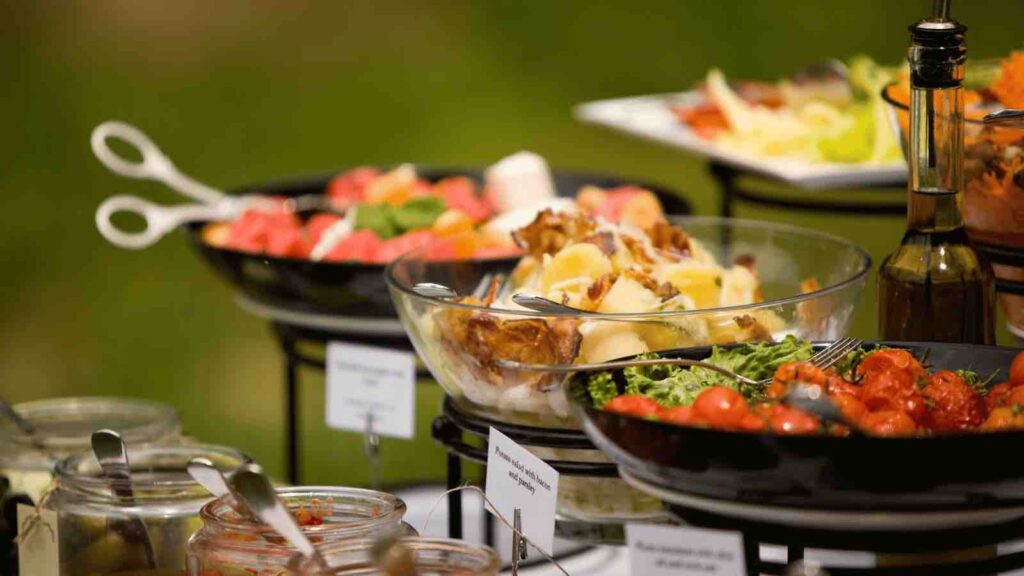Our plastic pollution crisis is too big for recycling to fix. It’stime to #actforthefuture #bergerakuntukmasadepan
In the bustling cities of Asia, where the age-old tradition of communal eating meets the modern sophistication of corporate conferences, the food on our plates tells a tale. It’s a narrative deeply rooted in Asia’s rich culinary heritage, interwoven with the current drive toward sustainability. At ChangeMakr Asia’s sustainability conferences, they’re serving up this narrative, dish by dish.
But how can the legacy of Asia, with its vast array of flavors and complex customs around food, inform and shape a sustainable future for conferences?
RELEVANT SUSTAINABLE GOALS


A Holistic Approach to a Sustainable Menu
From bountiful banquets in Beijing to modest meals in Mumbai, Asia’s food culture revolves around sharing, waste reduction, and deep respect for ingredients. ChangeMakr Asia leverages these principles in its 8-step guide for setting up a sustainable menu, which not only resonates with these age-old traditions but also addresses modern-day concerns.
1. Gradual Feasts: Portioning and Timing
In many Asian cuisines, dishes are brought out one by one, allowing diners to savor each dish while minimizing waste. By pre-portioning food and staggering its release, not only is the waste minimized, but any surplus remains in the kitchen, ready to be donated.
Surplus is a food rescue app in Indonesia which enable customers to buy meals from food-retailers who have surplus food/haven’t sold at the day with 50% discount. Surplus as the first “Food Rescue App” is filling the gap by providing an end-to-end solution that enables local food businesses; hotels & farms to sell their overstock product & imperfect produce with 50% off at the window time to the customers in order to avoid edible & untouched meals become food waste and end up in the landfill.
2.Serving with Modesty
Whether it’s the art of sushi presentation or the delicate arrangement of dim sum, smaller can often be more beautiful. By utilizing smaller serving platters, we can reduce waste, while still maintaining the aesthetics and abundance that Asian cuisine celebrates.
3.Meat and Cheese: Optional Delights On The Side
Adopting a deconstructed approach to meals ensures that the base remains plant-based, with the option for attendees to enhance their meals with animal-based products, catering to diverse palates and dietary requirements.
4.Opt Out For Single-Use Plastic
From bamboo steamers to banana leaves, Asia has a history of sustainable serving solutions. Instead of disposable plastics, the sustainable alternatives makes for a richer, more authentic dining experience.
5.Choosing the Right Culinary Companions
Much like the ancient Silk Road facilitated the sharing of ingredients and culinary techniques, partnering with knowledgeable stakeholders can help enrich and innovate your sustainable menu, drawing from Asia’s diverse culinary landscape.
6.Venue Collaboration: Playing to Strengths
Local chefs and venues bring with them a treasure trove of traditional knowledge. Tapping into their expertise ensures that the sustainable menu is both authentic and delicious, resonating with the sophisticated palates of attendees.
7.Provide Training
Introducing sustainable, plant-based alternatives might be new territory for some venues. By offering training sessions, we can bridge the gap, ensuring that traditional culinary techniques meet modern sustainable practices seamlessly.
8.A Gentle Nudge Towards Sustainability
While the push for sustainable eating is commendable, it’s essential to remember the diverse culinary backgrounds of attendees. Introducing them to sustainable options gradually ensures a positive experience, increasing the likelihood of them embracing these choices in the future.
Lead image courtesy of webphotographeer (via Getty Images Signature)
You may also be interested in :
Tossed Away : The Silent Crisis Of Food Loss and Food Waste in Southeast Asia


